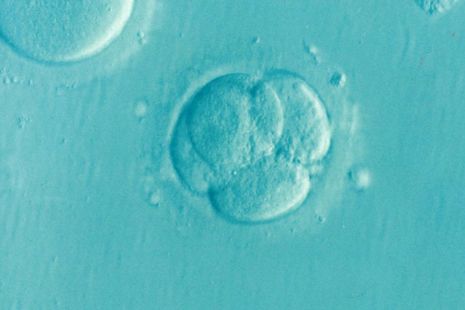Research Roundup: Week Three
Kalina Poydovska presents some of the latest scientific developments
Skin cell babies

The development of IVF (in-vitro fertilisation) is an incredible feat, helping same-sex and older couples to conceive. For IVF to work, however, the body must still be able to produce viable eggs. A team of scientists from Oregon Health and Science University may have found a way to circumvent this limitation, designing a new form of cell division called ‘mitomeiosis’ to effectively create egg cells from skin cells.
Essentially, a donor egg cell has its nucleus (the part of the cell containing its genetic material, in the form of DNA) removed and replaced with a skin cell nucleus. To do this, the mismatch in chromosome numbers must be addressed. Eggs have 23 chromosomes, pairing with 23 from sperm to form a complete organism. Since skin cells have 46 chromosomes, the two sets of genetic material were previously not interchangeable.
“Mitomeiosis takes advantage of the normal process of egg cell division, persuading skin cells to discard half of their chromosomes”
To understand how this novel technique works, some context on normal fertilisation is required. Immature egg cells are stored in the ovaries, frozen partway through the cell division process. They contain double the normal amount of genetic material; each of the 46 chromosomes has been copied. Each month, one egg cell resumes cell division (a process known as ‘meiosis’), dividing this genetic material between two new cells. Cell division pauses again at the stage called ‘metaphase II’. After fertilisation, the egg completes meiosis, splitting once more to produce a mature egg cell. This cell has 23 chromosomes, which can combine with the sperm cell’s 23 chromosomes to form a complete set of genetic material (that will later develop into an embryo).
Mitomeiosis takes advantage of this process, persuading skin cells to discard half of their chromosomes. The skin-cell nucleus is transferred to pre-fertilisation egg cells stuck in metaphase II. A drug called a cyclin-dependent kinase inhibitor is needed to push the new cell into the next stage of division. Hence, the egg cell’s normal mechanisms discard half of the skin cell’s chromosomes, just as they would have done naturally.
When the new cells were fertilised, however, less than 10% developed into early-stage embryos suitable for IVF. Chromosomes paired up randomly, producing incorrect combinations. Also, genetic information is normally shuffled between paired chromosomes to create new patterns in the offspring – this phenomenon was absent, which limits genetic diversity. The procedure seems far from ready for clinical use.
“This opens up the possibility that male skin cells could be reprogrammed into egg cells”
Nevertheless, these advances could bring even greater flexibility to IVF, broadening the range of cells that could be used as sources of genetic material. Much like the Polyjuice Potion in Harry Potter, a single skin cell might be sufficient to rcreate someone’s likeness. This also opens up the possibility that male skin cells could be reprogrammed into egg cells: perhaps Zeus birthing Athena from his head is not so fantastical after all.
A radical reimagining of solar panels
Cambridge researchers have demonstrated a way to use organic, rather than inorganic, materials for solar cells, which was previously thought unlikely. This could allow for the development of sleeker, more cost-efficient solar panels.
Normal solar cells are made from two types of inorganic silicon semiconductor (materials that conduct electricity only under certain, typically extreme, conditions) called n-type and p-type, joined at a critical junction. An electric field naturally forms there, acting as a one-way street for electrons. When sunlight reaches this junction, energy from light particles (photons) ‘knocks’ electrons from silicon atoms, freeing them and leaving ‘holes’ where they used to be.
The electric field ushers the electrons and holes to different sides of the cell, building a potential difference: one side becomes negatively charged with extra electrons and the other positively charged with holes. When the two sides are connected by a wire, electrons travel down the wire to balance out the difference in charge. This movement of electrons is a current, and thus energy from sunlight can be converted into electricity – the basis of solar panels.
“This could allow for the development of sleeker, more cost-efficient solar panels”
Rather than relying on two types of inorganic silicon and the junction between them, the scientists used only one organic semiconductor, called P3TTM (triphenyl-substituted TTM). Each molecule of this material has an electron that is unpaired and can more easily be transferred to other molecules, making it a ‘radical’.
When light hits the material, the unpaired electron from one molecule can jump to a neighbouring molecule. The original molecule gains a positive charge, since it has lost a negative electron, whereas the second molecule gains the electron and becomes negative. Positive and negative ions can either immediately recombine to emit light, or separate into free charges, generating current much like conventional solar cells.
Importantly, nearly all of the charge generated was successfully collected. This ‘close-to-unity charge collection’ is unprecedented for organic semiconductors, illustrating that they do have practical potential.
The single-material design is simpler, more flexible, and could enable the development of solar cells which are lighter and cheaper to manufacture.
 News / SU reluctantly registers controversial women’s soc18 December 2025
News / SU reluctantly registers controversial women’s soc18 December 2025 Features / Should I stay or should I go? Cambridge students and alumni reflect on how their memories stay with them15 December 2025
Features / Should I stay or should I go? Cambridge students and alumni reflect on how their memories stay with them15 December 2025 News / Dons warn PM about Vet School closure16 December 2025
News / Dons warn PM about Vet School closure16 December 2025 News / Cambridge study finds students learn better with notes than AI13 December 2025
News / Cambridge study finds students learn better with notes than AI13 December 2025 News / Uni registers controversial new women’s society28 November 2025
News / Uni registers controversial new women’s society28 November 2025










